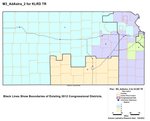


TOPEKA, Kan. — Gov. Laura Kelly signed off last Friday on new legislative district maps for both the Kansas House and Senate, as well as the US House of Representatives. According to state lawmakers, the changes made are because 2020 census data shows the state’s population shifting from rural to urban centers.
The Kansas Constitution requires lawmakers to redraw legislative districts every ten years to accommodate new population data gathered from the national census. These districts must be as equal in population as possible. According to the 2020 census, most of southeastern, central and parts of western Kansas lost population since 2010, while the Wichita area and northeast Kansas, around Kansas City and Leavenworth, saw an increase.
Many rural districts were merged while some urban districts were split as a result of the census, maintaining the 125 seats in the Kansas House of Representatives.
Rep. Ken Collins (R-Mulberry) said his 2nd District is now smaller in terms of area after shifting around boundaries. He has lost much of Bourbon and Allen counties, but has picked up some areas in Neosho County, notably Chanute, along with a few gains in Crawford County.
“I hate to lose the people I have worked with over the years,” said Collins, “but I am looking forward to working with my new constituents.”
Determining new districts for the state legislature proved to be a herculean task as lawmakers sought to make both house and senate districts as fair as possible. Several plans were proposed, discussed, dissected and discarded. The final plans, known as Freestate 3F for the House and Liberty 3 for the Senate, did pass with bipartisan support, but not without some hurt feelings.
Rep. Tatum Lee (R-Ness City) was not happy with the outcome, in which her district was combined with the district of Rep. Jim Minnix (R-Scott City).
"What happened today was pure political retaliation," Lee said. "Dictators don't like dissenters.”
Rep. Chris Croft (R-Overland Park), chair of the House Redistricting Committee, called the maps a fair compromise and praised members of both parties for their work.
The top Democrat on the House Redistricting Committee, Rep. Tom Burroughs (D-Kansas City), was skeptical of the map at first, but soon changed his stance, urging fellow Democrats to support the measure.
"I know there are some of you who aren't happy, some of you who think we could have done better," Burroughs said. "But it wasn't for a lack of effort."
The Kansas Senate’s new map saw more resistance from some lawmakers because it splits up parts of Topeka, Wichita, Lawrence and Kansas City.
“I think the populations in those urban and suburban areas have different interests and concerns than our rural neighbors and all of those folks need to have representatives who are dedicated to their interest,” said Sen. Ethan Corson (D-Fairway).
Both measures, for the house and senate, were packaged as a single bill and were signed by Gov. Laura Kelly last Friday, April 15.
The most controversial piece of the redistricting process came with federal representation in the US House of Representatives. State Republicans fended off several legal challenges and a gubernatorial veto to pass the Ad Astra 2 plan.
Democrats, the American Civil Liberties Union and the Campaign Legal Center filed two lawsuits against Kansas Republicans over a redistricting law that costs the state's only Democrat in Congress, U.S. Rep. Sharice Davids, some of her Kansas City-area district that she handily carries by wide margins.
The new law removes the northern part of Kansas City from the 3rd District and places it in the 2nd District, in exchange for Miami, Franklin, and Anderson counties moving from the 2nd to the 3rd District. The law also moved Lawrence, a Democratic stronghold, out of the 2nd District and into the 1st District.
The 2nd District, of which Pittsburg and Crawford County are a part, also gave up Marshall, Jackson, Jefferson, and northern Douglas (specifically the city of Lawrence) counties to the 1st District. In exchange, Lyon (Emporia), Chase, Marion, Morris, Wabaunsee, and Geary counties moved from the 1st to the 2nd District.
In its lawsuit against Kansas Republicans, the ACLU said GOP legislators were “manipulating the district boundaries to dilute the voting power of the minority party.”
Kansas Senate President Ty Masterson (R-Wichita), on the other hand, called the GOP map “politically fair," pointing out that Davids still would have won the 2020 election with the new district boundaries.
Gov. Kelly vetoed the bill, but both houses of the state legislature have since overridden her veto. The law must stand up to judicial review by the Kansas Supreme Court.
According to Kansas Attorney General Derek Schmidt, who is running for governor against Kelly as a Republican, he “is required by the state constitution to proactively seek judicial review of new legislative district boundaries in the Kansas Supreme Court.”
Schmidt said he will ask the court not only to review the boundaries but to approve them.